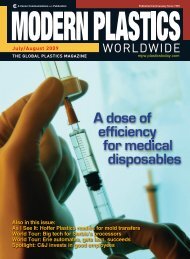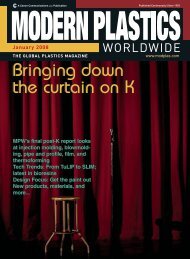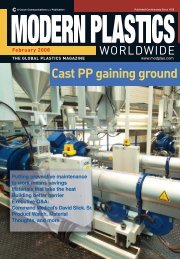amidiq - dae uptlax
amidiq - dae uptlax
amidiq - dae uptlax
You also want an ePaper? Increase the reach of your titles
YUMPU automatically turns print PDFs into web optimized ePapers that Google loves.
N. Balagurusamy / Revista Mexicana de Ingeniería Química Vol. 6, No. 3 (2007) 237-242<br />
discounted due to the fact that the predominant<br />
clostridia were cellulolytic in nature, as reported by<br />
O'Sullivan et al. (2005). They employed<br />
fluorescence in situ hybridization (FISH) to<br />
determine the structure of cellulose degrading<br />
microbial community in anaerobic digesters and the<br />
predominant bacterial group belonged to<br />
Clostridium. Similarly Shiratori et al. (2006)<br />
reported that clostridia with diverse phylogenetic<br />
positions specifically occurred during the period of<br />
high fermentation efficiency in a thermophilic<br />
methanogenic digester. However, construction of a<br />
library that includes a higher number of clones will<br />
increase the reliability of the data and a parallel<br />
analysis using cultivation dependent methods could<br />
aid in determining microbial biodiversity and their<br />
role in the performance of the anaerobic digesters.<br />
Acknowledgement<br />
The author wishes to thank Dr. David Huber, Dr.<br />
Umesh Reddy and Dr. Mark Chatfield of West<br />
Virginia State University, Institute, WV, USA for<br />
their help in providing lab facilities and all resources<br />
for this work.<br />
References<br />
Ahring, B.K. (2003). Perspectives for Anaerobic<br />
Digestion. Advances in Biochemical<br />
Engineering/ Biotechnology 82, 1-29.<br />
Ali, M. K., Kimura, T., Sakka, K. and Ohmiya, K.<br />
(2001). The multidomain xylanase Xyn10B as<br />
a cellulose-binding protein in Clostridium<br />
stercorarium. FEMS Microbiology Letters<br />
198, 79–83.<br />
Apajalahti, J., Kettunen, A. and Graham, H. (2004).<br />
Characteristics of the gastrointestinal<br />
microbial communities, with special reference<br />
to the chicken. World’s Poultry Science<br />
Journal 60, 223-232.<br />
Burrell, P.C., O’Sullivan, C., Song, H., Clarke, W.P.<br />
and Blackall, L.L. (2004). Identification,<br />
detection, and spatial resolution of<br />
Clostridium populations responsible for<br />
cellulose degradation in a methanogenic<br />
landfill leachate bioreactor. Applied and<br />
Environmental Microbiology 70, 2414–2419<br />
Buzzini, A.P., Sakamoto, I.K., Varesche, M.B. and<br />
Pires, E.C. (2006). Evaluation of the microbial<br />
diversity in an UASB reactor treating<br />
wastewater from an unbleached pulp plant.<br />
Process Biochemistry 41, 168-176.<br />
Chouari, R., Le Paslier, D., Daegelen, P., Ginestet,<br />
P., Weissenbach, J. and Sghir, A. (2005).<br />
Novel predominant archaeal and bacterial<br />
groups revealed by molecular analysis of an<br />
anaerobic sludge digester. Environmental<br />
Microbiology 7, 1104-1115.<br />
Cole, J.R., Chai, B., Farris, R.J., Wang, Q., Kulam,<br />
S.A., McGarrell, D.M., Garrity, G.M. and<br />
Tiedje, J.M. (2005). The ribosomal database<br />
project (RDP-II): sequences and tools for<br />
high-throughput rRNA analysis. Nucleic Acids<br />
Research 33, D294-D296.<br />
Daims, H., Ramsing, N.B., Schleifer, K.H. and<br />
Wagner, M. (2001). Cultivation-independent,<br />
semiautomatic determination of absolute<br />
bacterial cell numbers in environmental<br />
samples by fluorescence in situ hybridization.<br />
Applied and Environmental Microbiology 67,<br />
5810–5818.<br />
Dahllöf, I. (2002). Molecular community analysis of<br />
microbial diversity. Current Opinion in<br />
Biotechnology 13, 213-217.<br />
Drábková, L., Kirschner, J. and Vlcek, C. (2002).<br />
Comparison of seven DNA extraction and<br />
amplification protocols in historical herbarium<br />
specimens of Juncaceae. Plant Molecular<br />
Biology Reporter 20, 161–175.<br />
Espinosa-Solares, T., Bombardiere, J., Chatfield, M.,<br />
Domaschko, M., Easter, M., Stafford, D.A.,<br />
Castillo-Angeles, S. and Castellanos-<br />
Hernandez, N. (2006). Macroscopic mass and<br />
energy balance of a pilot plant anaerobic<br />
bioreactor operated under thermophilic<br />
conditions. Applied Biochemistry and<br />
Biotechnology 132, 959-968.<br />
Flora, J.R.V. and Riahi-Nezhad, C. (2006).<br />
Availability of poultry manure as a potential<br />
biofuel feedstock for energy production. p.23.<br />
South Carolina Energy Office, Columbia<br />
SC20201, USA.<br />
Godon, J.J., Zumstein, E., Dabert, P., Habouzit, F.<br />
and Moletta, R. (1997a). Molecular microbial<br />
diversity of an anaerobic digestor as<br />
determined by small-subunit rDNA sequence<br />
analysis. Applied and Environmental<br />
Microbiology 67, 2802-2813.<br />
Godon, J.J., Zumstein, E., Dabert, P., Habouzit, F.<br />
and Moletta, R. (1997b). Microbial 16S rDNA<br />
diversity in an anaerobic digester. Water<br />
Science and Technology 36, 40–55.<br />
Leung, K. and Topp, E. (2001). Bacterial community<br />
dynamics in liquid swine manure during<br />
storage: molecular analysis using DGGE/PCR<br />
of 16S rDNA. FEMS Microbiology Ecology<br />
38, 169-177.<br />
Lynd, L. R., Weimer, P.J., van Zyl, W.H. and<br />
Pretorius, I.S. (2002). Microbial cellulose<br />
utilization: fundamentals and biotechnology.<br />
Microbiology and Molecular Biology Reviews<br />
66, 506–577.<br />
McInerney, M.J. (1999). Anaerobic Metabolism and<br />
its Regulation. In: Biotechnology: a multi<br />
volume comprehensive treatise, (H.-J. Rehm,<br />
G. Reed, A. Pühler, and P.I.W. Stadler, eds.),<br />
Vol. 11a. Environmental Processes I -<br />
Wastewater Treatment, (J. Winter, ed.), pp.<br />
241









